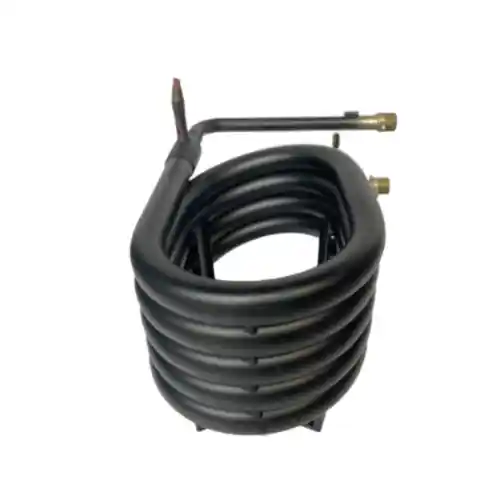1. Introduction
In the realm of coaxial heat exchangers, stainless steel tubes have gained significant popularity due to their unique properties and suitability for various applications. This article explores the characteristics, advantages, and applications of stainless steel tubes in coaxial heat exchangers. We will delve into the different types of stainless steel tubes, their features, and compare them with other materials commonly used in heat exchangers. Additionally, we will analyze their impact on heat transfer efficiency, durability, and overall performance.
2. Types of Stainless Steel Tubes for Coaxial Heat Exchangers
2.1 Austenitic Stainless Steel Tubes
Austenitic stainless steel tubes are the most widely used type in coaxial heat exchangers. They are characterized by their excellent corrosion resistance, high ductility, and low thermal conductivity. The austenitic structure of these tubes, primarily composed of nickel and chromium, offers superior resistance to corrosion caused by various fluids, including acids and alkalis. The following table compares the composition and properties of austenitic stainless steel tubes:
| Stainless Steel Grade | Composition (%) | Tensile Strength (MPa) | Yield Strength (MPa) | Thermal Conductivity (W/m·K) |
|---|---|---|---|---|
| 304 | 18-20% Cr, 8-10.5% Ni | 515-690 | 205 | 15.1 |
| 316 | 16-18% Cr, 10-14% Ni | 515-690 | 205 | 14.6 |
| 321 | 17-20% Cr, 9-12% Ni | 515-690 | 205 | 15.0 |
2.2 Duplex Stainless Steel Tubes
Duplex stainless steel tubes exhibit a unique microstructure comprising both austenite and ferrite phases. This structure provides enhanced strength, corrosion resistance, and resistance to stress corrosion cracking. Duplex stainless steel tubes are commonly used in applications where high mechanical strength and resistance to aggressive environments are required. The following table presents a comparison of duplex stainless steel grades:
| Stainless Steel Grade | Composition (%) | Tensile Strength (MPa) | Yield Strength (MPa) | Thermal Conductivity (W/m·K) |
|---|---|---|---|---|
| 2205 | 21-23% Cr, 4.5-6.5% Ni, 2.5-3.5% Mo | 620-930 | 450 | 14.2 |
| 2507 | 24-26% Cr, 6-8% Ni, 3-4% Mo | 750-1000 | 550 | 13.7 |
2.3 Martensitic Stainless Steel Tubes
Martensitic stainless steel tubes are characterized by their high strength, hardness, and moderate corrosion resistance. They find applications in environments with higher temperatures and lower corrosive conditions. Martensitic stainless steel tubes have a martensitic microstructure and contain higher carbon content, resulting in increased hardness. However, their corrosion resistance may be lower compared to austenitic and duplex stainless steel tubes.
3. Advantages of Stainless Steel Tubes in Coaxial Heat Exchangers
3.1 Corrosion Resistance
One of the key advantages of stainless steel tubes in coaxial heat exchangers is their exceptional corrosion resistance. The chromium content in stainless steel forms a protective oxide layer on the surface, preventing the material from corroding when exposed to corrosive fluids or environments. This corrosion resistance ensures prolonged service life and reduces the need for frequent maintenance, leading to cost savings.
3.2 High Strength and Durability
Stainless steel tubes exhibit excellent mechanical properties, including high strength and durability. This enables them to withstand high temperatures, pressures, and mechanical stresses encountered in heat exchanger applications. Their robustness and resistance to deformation ensure long-term performance and reliability, reducing the risk of failure and downtime.
3.3 Thermal Conductivity
Although stainless steel has lower thermal conductivity compared to materials like copper, its thermal properties are still sufficient for many heat transfer applications. Moreover, the lower thermal conductivity of stainless steel can be advantageous in certain scenarios, such as reducing heat loss in specific processes or applications requiring controlled heat transfer.
4. Comparison with Other Materials
| Material | Corrosion Resistance | Strength | Thermal Conductivity |
|---|---|---|---|
| Cobre | Excellent | Moderate | High |
| Acero inoxidable | Excellent | High | Moderate to High |
| Aluminum | Good | Moderate | Moderate |
5. Applications of Stainless Steel Tubes in Coaxial Heat Exchangers
Stainless steel tubes find extensive use in various applications involving coaxial heat exchangers. Some notable applications include:
5.1 Chemical Processing
In chemical processing industries, stainless steel tubes are preferred due to their excellent corrosion resistance and resistance to chemical reactions. These tubes are used in heat exchangers involved in the cooling and heating of corrosive fluids, ensuring efficient and reliable operation.
5.2 Food and Beverage Industry
The food and beverage industry requires hygienic heat exchangers that can withstand frequent cleaning and sterilization processes. Stainless steel tubes are suitable for such applications due to their corrosion resistance, cleanliness, and compliance with food safety standards.
5.3 Oil and Gas Industry
Coaxial heat exchangers with stainless steel tubes are widely used in the oil and gas industry for various processes, including refining, petrochemical production, and offshore applications. The corrosion resistance and mechanical strength of stainless steel tubes make them ideal for withstanding harsh operating conditions.
6. Conclusion
Stainless steel tubes offer several advantages in coaxial heat exchangers, including excellent corrosion resistance, high strength, durability, and thermal conductivity. Different grades of stainless steel, such as austenitic, duplex, and martensitic, provide options for various applications and environments. Stainless steel tubes find applications in chemical processing, food and beverage industry, oil and gas industry, and more. Their reliability, longevity, and performance make them a preferred choice for efficient heat transfer in diverse industries.


